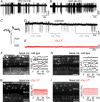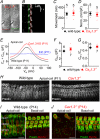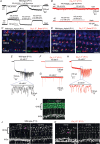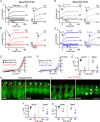Hair cell maturation is differentially regulated along the tonotopic axis of the mammalian cochlea
- PMID: 31661723
- PMCID: PMC6972525
- DOI: 10.1113/JP279012
Hair cell maturation is differentially regulated along the tonotopic axis of the mammalian cochlea
Abstract
Key points: Outer hair cells (OHCs) enhance the sensitivity and the frequency tuning of the mammalian cochlea. Similar to the primary sensory receptor, the inner hair cells (IHCs), the mature functional characteristics of OHCs are acquired before hearing onset. We found that OHCs, like IHCs, fire spontaneous Ca2+ -induced action potentials (APs) during immature stages of development, which are driven by CaV 1.3 Ca2+ channels. We also showed that the development of low- and high-frequency hair cells is differentially regulated during pre-hearing stages, with the former cells being more strongly dependent on experience-independent Ca2+ action potential activity.
Abstract: Sound amplification within the mammalian cochlea depends upon specialized hair cells, the outer hair cells (OHCs), which possess both sensory and motile capabilities. In various altricial rodents, OHCs become functionally competent from around postnatal day 7 (P7), before the primary sensory inner hair cells (IHCs), which become competent at about the onset of hearing (P12). The mechanisms responsible for the maturation of OHCs and their synaptic specialization remain poorly understood. We report that spontaneous Ca2+ activity in the immature cochlea, which is generated by CaV 1.3 Ca2+ channels, differentially regulates the maturation of hair cells along the cochlea. Under near-physiological recording conditions we found that, similar to IHCs, immature OHCs elicited spontaneous Ca2+ action potentials (APs), but only during the first few postnatal days. Genetic ablation of these APs in vivo, using CaV 1.3-/- mice, prevented the normal developmental acquisition of mature-like basolateral membrane currents in low-frequency (apical) hair cells, such as IK,n (carried by KCNQ4 channels), ISK2 and IACh (α9α10nAChRs) in OHCs and IK,n and IK,f (BK channels) in IHCs. Electromotility and prestin expression in OHCs were normal in CaV 1.3-/- mice. The maturation of high-frequency (basal) hair cells was also affected in CaV 1.3-/- mice, but to a much lesser extent than apical cells. However, a characteristic feature in CaV 1.3-/- mice was the reduced hair cell size irrespective of their cochlear location. We conclude that the development of low- and high-frequency hair cells is differentially regulated during development, with apical cells being more strongly dependent on experience-independent Ca2+ APs.
Keywords: action potentials; auditory; calcium signals; cochlea; development; hair cells.
© 2019 The Authors. The Journal of Physiology published by John Wiley & Sons Ltd on behalf of The Physiological Society.
Figures










Comment in
-
A maturing view of cochlear calcium.J Physiol. 2020 Jan;598(1):7-8. doi: 10.1113/JP279215. Epub 2019 Dec 26. J Physiol. 2020. PMID: 31745992 No abstract available.
Similar articles
-
Developmental changes in the cochlear hair cell mechanotransducer channel and their regulation by transmembrane channel-like proteins.J Gen Physiol. 2013 Jan;141(1):141-8. doi: 10.1085/jgp.201210913. J Gen Physiol. 2013. PMID: 23277480 Free PMC article.
-
Functional maturation of the exocytotic machinery at gerbil hair cell ribbon synapses.J Physiol. 2009 Apr 15;587(Pt 8):1715-26. doi: 10.1113/jphysiol.2009.168542. Epub 2009 Feb 23. J Physiol. 2009. PMID: 19237422 Free PMC article.
-
Gata3 is required for the functional maturation of inner hair cells and their innervation in the mouse cochlea.J Physiol. 2019 Jul;597(13):3389-3406. doi: 10.1113/JP277997. Epub 2019 May 28. J Physiol. 2019. PMID: 31069810 Free PMC article.
-
How to build an inner hair cell: challenges for regeneration.Hear Res. 2007 May;227(1-2):3-10. doi: 10.1016/j.heares.2006.12.005. Epub 2006 Dec 16. Hear Res. 2007. PMID: 17258412 Review.
-
Efferent Inhibition of the Cochlea.Cold Spring Harb Perspect Med. 2019 May 1;9(5):a033530. doi: 10.1101/cshperspect.a033530. Cold Spring Harb Perspect Med. 2019. PMID: 30082454 Free PMC article. Review.
Cited by
-
An in vivo Biomarker to Characterize Ototoxic Compounds and Novel Protective Therapeutics.Front Mol Neurosci. 2022 Jul 18;15:944846. doi: 10.3389/fnmol.2022.944846. eCollection 2022. Front Mol Neurosci. 2022. PMID: 35923755 Free PMC article.
-
Postnatal structural development of mammalian Basilar Membrane provides anatomical basis for the maturation of tonotopic maps and frequency tuning.Sci Rep. 2021 Apr 7;11(1):7581. doi: 10.1038/s41598-021-87150-w. Sci Rep. 2021. PMID: 33828185 Free PMC article.
-
Biophysical and morphological changes in inner hair cells and their efferent innervation in the ageing mouse cochlea.J Physiol. 2021 Jan;599(1):269-287. doi: 10.1113/JP280256. Epub 2020 Nov 17. J Physiol. 2021. PMID: 33179774 Free PMC article.
-
Oncomodulin (OCM) uniquely regulates calcium signaling in neonatal cochlear outer hair cells.Cell Calcium. 2022 Jul;105:102613. doi: 10.1016/j.ceca.2022.102613. Epub 2022 Jun 24. Cell Calcium. 2022. PMID: 35797824 Free PMC article.
-
New Tmc1 Deafness Mutations Impact Mechanotransduction in Auditory Hair Cells.J Neurosci. 2021 May 19;41(20):4378-4391. doi: 10.1523/JNEUROSCI.2537-20.2021. Epub 2021 Apr 6. J Neurosci. 2021. PMID: 33824189 Free PMC article.
References
-
- Ashmore J (2008). Cochlear outer hair cell motility. Physiol Rev 88, 173–210. - PubMed
Publication types
MeSH terms
Substances
Grants and funding
LinkOut - more resources
Full Text Sources
Miscellaneous

